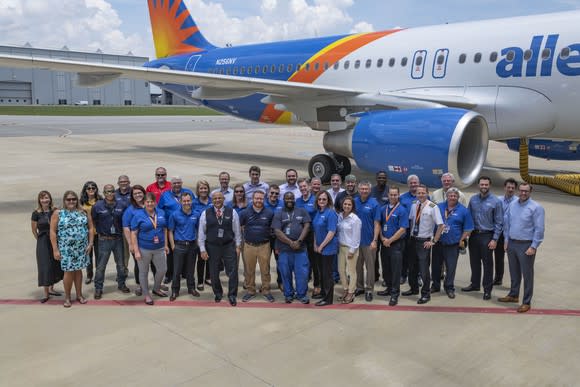Spirit Airlines Announces a New Growth Surge
In early 2016, Spirit Airlines (NYSE: SAVE) CEO Bob Fornaro -- then in his first few months on the job -- told investors that the budget carrier planned to be less predictable in choosing new routes going forward. At the time, Spirit was struggling to adapt to the growing trend of legacy carriers aggressively matching its low fares.
Two years later, Spirit Airlines still hasn't been able to replicate its former success in the new competitive environment. As a result, its route strategy continues to evolve. Since the beginning of June, the carrier has announced a slew of new routes. The route selection indicates that Spirit is tilting even more of its growth toward small and midsize cities. In doing so, it is taking a page out of fellow ultra-low-cost carrier Allegiant Travel's (NASDAQ: ALGT) book.
Spirit Airlines is still under pressure
Revenue per available seat mile (RASM) first began to slip at Spirit Airlines in 2014, falling 1% year over year. The unit revenue erosion accelerated dramatically in 2015, as RASM plummeted 14.7%, driven by stepped-up competition from legacy carriers along with Spirit's own rapid growth.
Nevertheless, Spirit Airlines posted a record profit in 2015, as its average fuel price plunged by almost 40%. The problems really began in 2016, when fuel prices started to stabilize, but RASM fell another 9.6% year over year.

Spirit Airlines has experienced rapid unit revenue erosion in recent years. Image source: Spirit Airlines.
To his credit, Fornaro (the CEO) quickly realized that strategic changes were needed to stem the declines in unit revenue. By late 2016, Spirit was already directing more of its growth toward small and midsize markets where it wouldn't compete directly with any of the legacy carriers.
Initially, these efforts appeared to be successful, as RASM returned to modest growth in the first half of 2017, inching up 0.9%. Unfortunately, the momentum didn't last. Unit revenue plunged in the second half of the year, due to the lingering impacts of a pilot dispute that forced Spirit to cancel hundreds of flights last May, along with an even more brutal competitive environment. These unit revenue declines have continued in the first half of 2018.
Moving further into smaller markets
Spirit Airlines' June route announcements will shift the carrier's growth even more toward small and midsize cities. To be sure, some of the new routes touch legacy carrier hubs, such as Newark-Atlanta, Philadelphia-Fort Myers, and Philadelphia-Tampa. However, those are now the exception rather than the norm.
First, Spirit Airlines added two new routes in Myrtle Beach, South Carolina. It will fly twice a week from Myrtle Beach to Baltimore/Washington and Orlando. This infrequent service marks a shift in strategy for Spirit, which until recently flew the vast majority of its routes on a daily basis. By contrast, fellow budget carrier Allegiant Air has historically operated in lots of smaller markets, flying most routes just two or three times a week.

Allegiant operates nearly all of its routes just a few times a week. Image source: Airbus.
Myrtle Beach is a popular regional leisure destination with limited legacy carrier service. In fact, Spirit has more than 50% market share in Myrtle Beach. Allegiant is the second-busiest airline there over the summer, although it doesn't operate in Myrtle Beach at all during the winter.
This week, Spirit announced that it will add two new small markets to its route network this fall: Greensboro, North Carolina and Asheville, North Carolina. It will fly year-round from both cities to Orlando, Fort Lauderdale, and Tampa. Once again, each of these routes will be operated a few times a week.
Most recently, Spirit Airlines revealed that it will launch a slew of routes this fall from Orlando to 11 destinations in Latin America and the Caribbean. It already serves all 11 destinations today, mainly from its home base in Fort Lauderdale.
These new routes will give Spirit up to 49 daily departures in Orlando, making Orlando one of its three largest focus cities. Seven of the 11 routes will operate less than daily. Spirit Airlines will primarily serve origin-and-destination traffic on these new routes to Latin America and the Caribbean, but it also expects to carry some connecting traffic.
Is this the answer?
With fuel prices having risen sharply over the past six months, it is more important than ever for Spirit Airlines to get unit revenue growing again. The intensity of competition in the biggest airline hubs has made this task very challenging. (Spirit has a substantial presence in places like Chicago, Dallas, Houston, and Los Angeles.)
By contrast, there won't be much nonstop competition on Spirit's new routes. On many of its new domestic routes, Allegiant is its only direct competitor. For many of the Caribbean and Latin America routes, Spirit will offer the only nonstop flights.
Only time will tell if these new routes succeed. However, I like what Spirit is doing here. By moving into smaller markets, it is returning to a business model based on stimulating new traffic with low fares. That's preferable to getting sucked ever more deeply into competitive battles in other carriers' hubs, where those rivals are often willing to cut fares to absurdly low levels to protect their market share.
More From The Motley Fool
Adam Levine-Weinberg owns shares of Spirit Airlines. The Motley Fool owns shares of Spirit Airlines. The Motley Fool has a disclosure policy.
